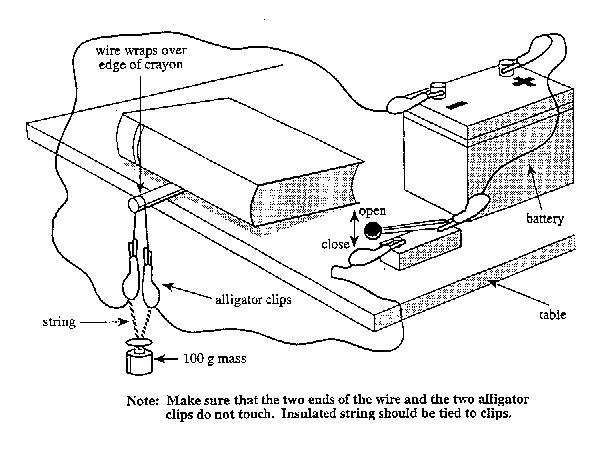Contributed by: Council of Chief State School Officers (CCSSO/SCASS)
TO THE STUDENT
Welcome to this science exercise. We hope that you will find it
interesting and worthwhile. Carefully read through these directions
and the directions on the next page before you begin to work.
You may be part of a group for the first part of this exercise.
Each group should carry out the experiment and collect the data
together, but each student must record the data in his or her own
booklet. Be sure to record the data exactly as you see it. After
the data has been collected, each student should answer the questions
independently.
After you have finished your experiment and have recorded all
of the data, you will be asked to answer some questions about the
experiment and the data you recorded. Your answers must be written
in this test booklet in the space provided. Make sure that you understand
each question before you begin to write. At any time while you are
writing your answers, you may look back to the directions for the
experiment and the data you collected. Be sure that your answers
are written as clearly and neatly as possible.
Before you turn the page, read the list of materials given below
and check to make sure that your group has everything listed.
Materials in the Kit
- battery
- knife switch
- 3 alligator clips
- 4 strands of wire
- 100-g mass
- crayon
- book
- clock
- string
- scissors
- metric rulers
- pen or pencil
|
|
AFTER YOU HAVE READ THE DIRECTIONS, TURN TO THE NEXT PAGE
AND BEGIN.
Electrical Energy
When voltage is applied across a conducting wire, we may think
of the electrons as being jostled against each other. This motion
causes the wire to heat up. This is how toasters, electric heaters,
and hair dryers work. Some wires are better radiators of heat than
others. This event is designed to investigate the relationship between
different types of wires and their ability to radiate heat.
Assume that you have a space heater that operates on a 6 volt
battery. You discover that a wire in the heater is broken. The following
types of wires are available at the store.
- 32-gauge copper
- 36-gauge copper
- 32-gauge steel
- 32-gauge nichrome
You will now conduct an experiment to find out how well each wire
radiates heat. You will hang a wire with a weight attached over
a crayon and then run electrical current through it. The time it
takes the wire to cut through the crayon will indicate how well
that wire radiates heat.
- Construct the circuit shown in the diagram below.

- Remove the paper from the crayon.
- Hang the wire 1 cm from the end of the crayon. It is crucial
that there be a complete pathway for the flow of electricity,
as indicated in the diagram.
- Hang the weight from the clips. Use the string, not the
wire.
- Do not allow the pull of the weight to draw the two clips together.
Make sure that the insulating covers are over the clips.
- Do not close the knife switch or complete the circuit until
you are ready to start timing.
IMPORTANT: ONCE THE CIRCUIT IS CLOSED, THE BATTERY AND ALL
OF THE WIRES WILL BECOME HOT. USE ONLY THE KNIFE SWITCH TO OPEN
AND CLOSE THE CIRCUIT. ALLOW ALL WIRES TO COOL BEFORE HANDLING
THEM.
- Close the knife switch to make the connection complete and start
the stopwatch at the same time. After the current begins to flow
through the wire, make sure that the wires do not touch, or your
circuit will be shorted out. Also, do not pull down on or influence
mass in any way.
- As soon as the wire cuts all the way through the crayon and
the weight drops, STOP THE STOPWATCH, THEN OPEN THE KNIFE SWITCH
SO ELECTRICITY STOPS FLOWIN THROUGH THE CIRCUIT. Record the time
in Table 1. Repeat this procedure for the rest of the wires.
- Give each wire no longer than 5 minutes to cut through the crayon.
If it has not cut completely through in 5 minutes, record how
far the wire has cut through the crayon in that time.
- After you are finished clean up your work area.
Table 1
| |
Time (in seconds) |
| 32-gauge copper |
|
| 36-gauge copper |
|
| 32-gauge nichrome |
|
| 32-gauge steel |
|
Additional observations:
Questions
Please answer the following questions by yourself.
- Explain your experimental results. Include in your answer a
discussion of how the gauge of a wire and type of wire affect
the amount of heat radiated.
___________________________________________________________________
___________________________________________________________________
___________________________________________________________________
___________________________________________________________________
- Which of the wires would you use to repair your space heater?
Be sure to justify your answer using the data you collected.
___________________________________________________________________
___________________________________________________________________
___________________________________________________________________
___________________________________________________________________
|


